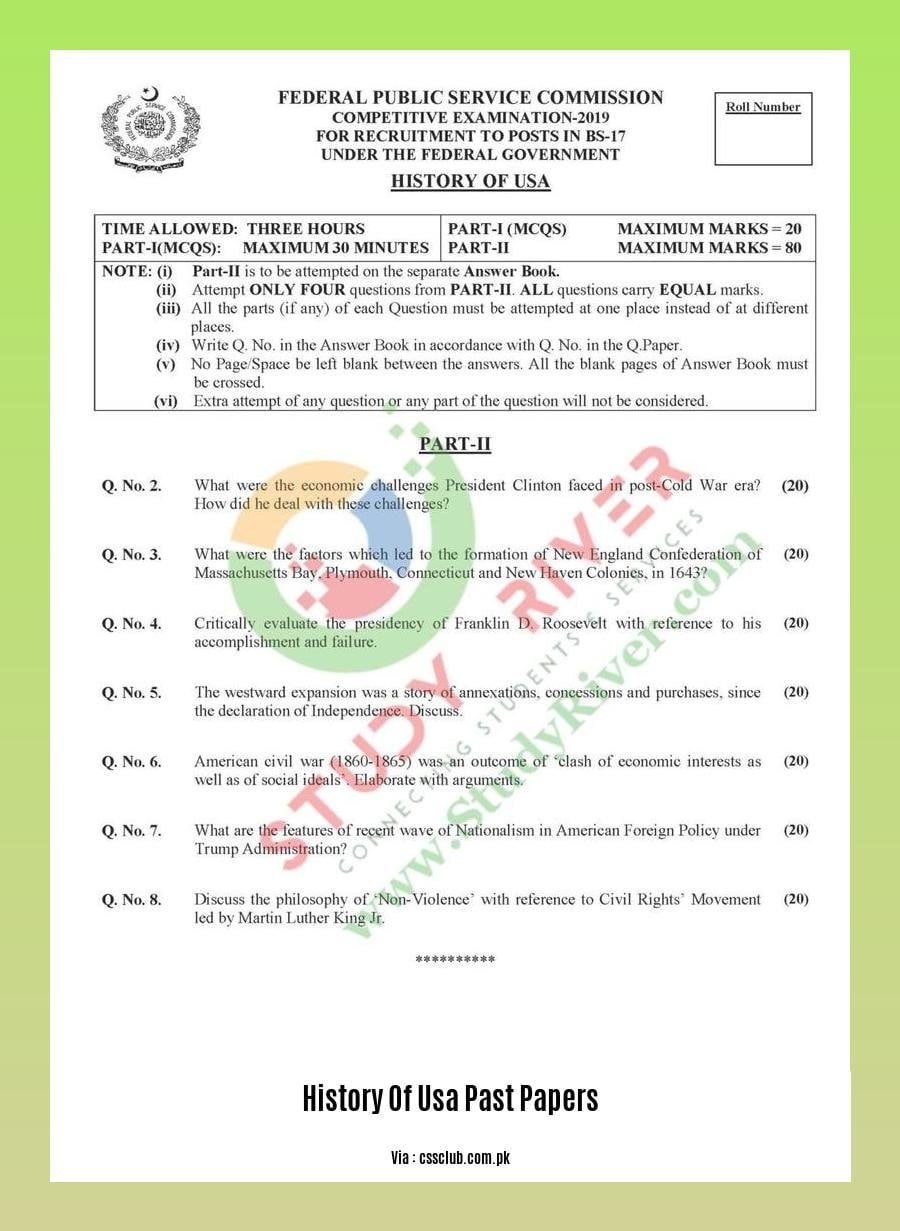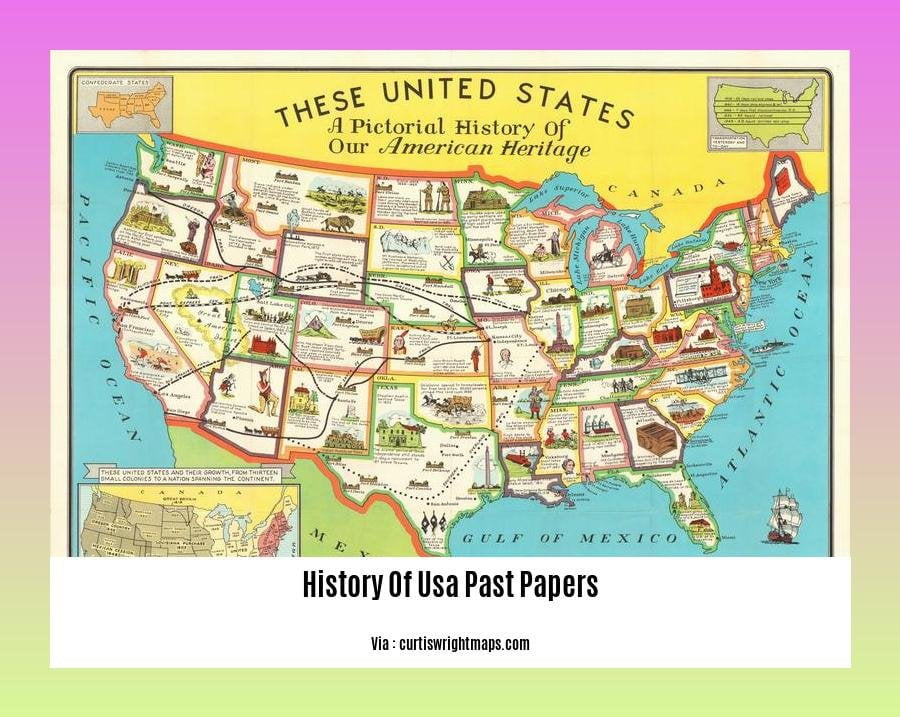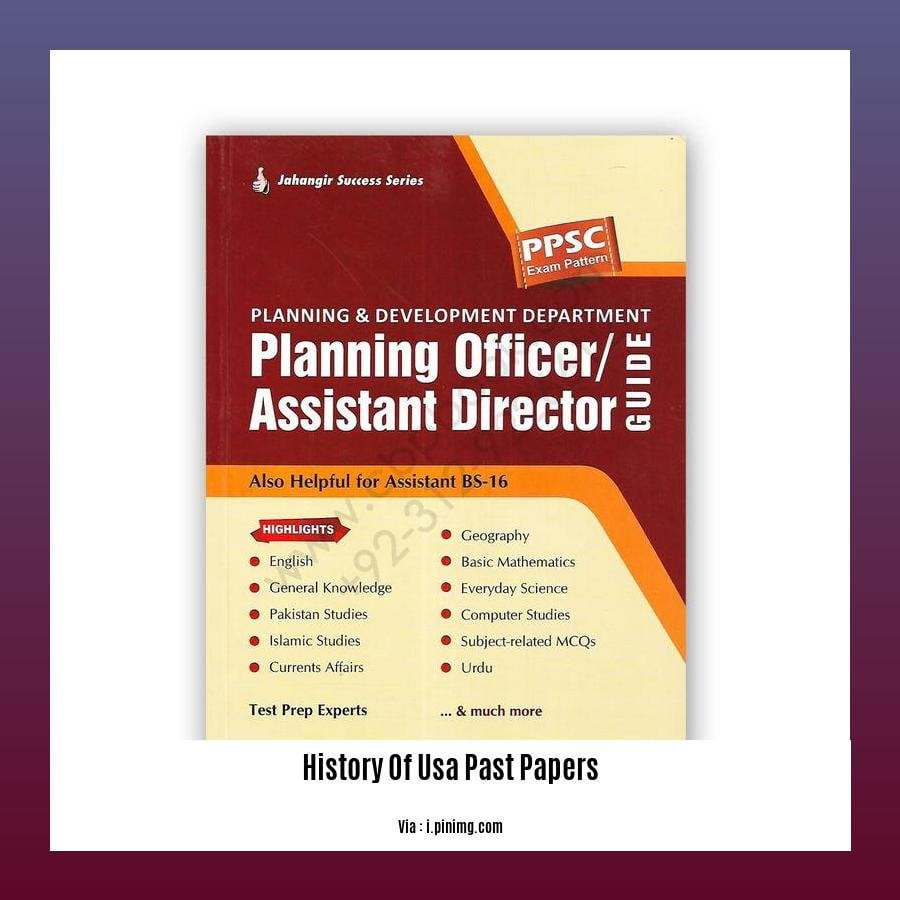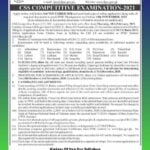Embark on a journey through time with “History of USA Past Papers: Delving into America’s Past for Academic Success.” Prepare to unravel the intricate tapestry of American history as we explore a treasure trove of past papers, unlocking the secrets of this nation’s rich and diverse heritage. Glean insights into the founding principles, pivotal events, and influential figures that have shaped the United States, equipping yourself with the knowledge and understanding necessary for academic triumph.
Key Takeaways:
- CSS History of USA past papers cover the years 2000 to 2021.
- These papers help candidates prepare for the CSS exam in Pakistan.
- Cambridge IGCSE American History past papers focus on the history of the USA from the mid-18th century to the present day.
History of USA Past Papers: A Gateway to Unlocking American History

Studying the history of the United States is a captivating journey through the annals of a nation that has played a pivotal role in shaping the modern world. For those aspiring to delve deeper into this fascinating subject, past papers serve as an invaluable resource, providing insights into the content, format, and assessment criteria of various examinations.
In this article, we’ll explore the significance of history of USA past papers, uncovering their benefits for students and providing practical tips on how to utilize them effectively.
1. Unveiling Examination Patterns and Trends:
- Past papers offer a glimpse into the structure, content, and difficulty level of history of USA examinations.
- Studying past papers helps identify recurring themes, topics, and question types, providing a strategic advantage.
- Candidates can gauge the depth of knowledge required and adjust their study strategies accordingly.
2. Refining Analytical Skills and Critical Thinking:
- Engaging with past papers enhances critical thinking skills by requiring candidates to analyze and interpret historical sources.
- Evaluating past responses allows students to understand the expectations of examiners and improve their argumentation and reasoning abilities.
- Honing these skills leads to a deeper comprehension of historical concepts and a well-rounded understanding of the subject.
3. Building Confidence and Reducing Exam Anxiety:
- Familiarity with past papers instills confidence and reduces anxiety by exposing candidates to the examination format and question styles.
- Practicing under timed conditions simulates the exam environment, helping students manage their time effectively and avoid surprises on the actual exam day.
- The experience of successfully answering past paper questions reinforces knowledge and boosts confidence.
4. Identifying Areas for Improvement and Targeted Revision:
- Evaluating past papers helps students identify areas where they need to focus their revision efforts.
- By analyzing common mistakes or weaknesses in past responses, candidates can pinpoint gaps in their knowledge and allocate study time accordingly.
- This targeted approach ensures that students optimize their revision and address areas that require extra attention.
5. Enhancing Writing Skills and Expression:
- Past papers provide examples of well-written and structured historical responses.
- Studying these responses helps students improve their writing style, clarity, and organization of ideas.
- By emulating effective writing techniques, candidates can enhance their ability to communicate their knowledge effectively in exams.
Tips for Effective Utilization of History of USA Past Papers:
- Begin Early: Start practicing with past papers well in advance of the exam to allow ample time for analysis and revision.
- Create a Realistic Exam Environment: Simulate the exam conditions by setting a timer and working in a quiet, distraction-free space.
- Review Answers and Marks Schemes: After completing a past paper, carefully review the answers and marking schemes to understand the criteria for assessment.
- Compare Your Responses: Compare your answers to sample responses or those of peers to identify areas for improvement.
- Focus on Quality, Not Quantity: It’s better to thoroughly analyze a few past papers than to rush through many without proper reflection.
- Seek Feedback: Share your answers with teachers, tutors, or peers for constructive feedback.
In conclusion, history of USA past papers are an invaluable tool for students preparing for examinations. By utilizing these resources effectively, candidates can gain insights into exam patterns, refine their analytical skills, boost their confidence, identify areas for improvement, and enhance their writing abilities. Embracing past papers as a part of your study routine will undoubtedly contribute to your success in understanding and mastering the history of the United States.
Discover the intriguing history of the United States CSS syllabus by clicking on history of usa css syllabus.
Explore the captivating history of Venice canals, a city known for its unique watery charm, by following this link: history of venice canals.
Delve into the fascinating history of volleyball in Sri Lanka, a sport that has gained immense popularity over the years, by clicking on history of volleyball in sri lanka.
Uncover the rich history of volleyball in the Philippines, a country where the sport holds a special place in the hearts of many, by following this link: history of volleyball in the philippines.
The Development of the American Identity, Culture, and Values

In the melting pot of cultures that is America, the very essence of what it means to be an American has been in a constant state of evolution. Spanning across time, the rich tapestry of American identity, culture, and values has been shaped by a confluence of factors – from the nation’s diverse immigrant heritage to the profound influence of historical figures.
Forming the American Crucible
The genesis of the American identity can be traced back to the tumultuous colonial era when settlers from across the globe sought refuge on these shores. As these disparate groups intermingled, a unique American culture began to take shape – a vibrant mosaic of customs, traditions, and beliefs that defied easy categorization.
Cultural Convergence: A Tapestry of Traditions
The American cultural landscape is a kaleidoscope of influences, each contributing its unique hue to the overall masterpiece. From the vibrant festivals that celebrate diverse heritages to the eclectic culinary landscape that reflects a global palate, American culture is a testament to its welcoming nature.
Evolving Values: A Nation in Flux
The American value system, too, has undergone a dynamic transformation over the years. Rooted in the ideals of liberty, equality, and justice, these values have been constantly tested and refined as the nation grappled with issues of race, gender, and social equality. Yet, despite the challenges, America’s core values have remained a beacon of hope for those seeking a better life.
Key Takeaways:
American identity is a fluid concept, continuously shaped by waves of immigration and the intermingling of diverse cultures.
American culture is a vibrant tapestry of traditions, customs, and beliefs, reflecting the nation’s diverse heritage.
American values, rooted in the ideals of liberty, equality, and justice, have evolved over time, reflecting the nation’s ongoing journey towards a more just and equitable society.
Modern and historical political leaders have played a pivotal role in shaping American identity, culture, and values.
American identity is an ongoing work in progress, constantly adapting to the changing demographics, cultural influences, and societal values of the nation.
Sources:
[1]
[2]
Challenges and Opportunities the United States Faced Throughout Its History
Think about a country that has been around for hundreds of years. It has faced many ups and downs along the way, from wars and economic depressions to social and cultural changes. The United States is no exception. In its relatively short history, it has encountered numerous challenges and opportunities that have shaped it into the nation it is today.
One of the earliest challenges the US faced was the Civil War. This bloody conflict between the North and South over the issue of slavery tested the very foundation of the nation. The war resulted in the abolition of slavery, but it also left a legacy of racial discrimination that would continue to haunt the country for generations.
In the early 20th century, the US faced a new set of challenges, including two World Wars, the Great Depression, and the Cold War. These events had a profound impact on the country, both domestically and internationally. The US emerged from these challenges as a global superpower, but it also faced new threats, such as the rise of communism and the threat of nuclear war.
In the latter half of the 20th century, the US faced a number of social and cultural changes, including the Civil Rights Movement, the Vietnam War, and the Watergate scandal. These events challenged the country’s values and institutions and led to a period of great social unrest. However, they also helped to bring about positive changes, such as the end of segregation and the increased participation of women and minorities in American society.
In the 21st century, the US has faced a number of new challenges, including the 9/11 terrorist attacks, the Iraq War, and the Great Recession. These events have had a significant impact on the country, both domestically and internationally. The US is still grappling with the challenges of terrorism, economic inequality, and climate change. However, it is also a nation of immigrants and entrepreneurs, and it has a long history of overcoming adversity.
Key Takeaways:
The US has faced many challenges and opportunities throughout its history.
These challenges and opportunities have shaped the nation into what it is today.
The US is a resilient nation that has overcome many challenges in the past.
It is likely to continue to face challenges in the future, but it is well-positioned to meet them.
Sources:
1. The Challenges of Peacetime
2. TakeLessons History Tutoring
The influence of the U.S. on Global Affairs
Imagine a world where the United States had never emerged as a superpower. How different would our world be? The influence of the U.S. on global affairs has been profound, shaping the world we live in today.
The United States as a Global Power
The United States’ rise to global prominence is a relatively recent development. It wasn’t until the late 19th century that the U.S. began to assert its influence on the world stage. This rise was due, in part, to the country’s economic power. The United States had a vast and rapidly growing economy, which gave it the resources to project its power around the globe.
The United States’ Role in World Wars I and II
The United States’ involvement in World War I and World War II solidified its status as a global power. In both wars, the U.S. played a major role in defeating the Axis powers. This military victory gave the U.S. a great deal of prestige and influence on the world stage.
The United States and the Cold War
After World War II, the United States and the Soviet Union emerged as the two superpowers in the world. The Cold War was a period of intense rivalry between these two countries. The United States played a leading role in containing the spread of communism, and it provided economic and military assistance to its allies around the world.
The United States in the Post-Cold War Era
The end of the Cold War did not diminish the influence of the U.S. on global affairs. The United States remained the world’s sole superpower, and it continued to play a major role in global politics. The U.S. has been involved in numerous military interventions in recent years, and it has also been a major player in efforts to promote democracy and human rights around the world.
Key Takeaways:
- The United States’ rise to global prominence is a relatively recent development.
- The United States’ involvement in World War I and World War II solidified its status as a global power.
- The United States played a leading role in containing the spread of communism during the Cold War.
- The end of the Cold War did not diminish the influence of the U.S. on global affairs.
- The United States remains the world’s sole superpower and continues to play a major role in global politics.
Relevant URL Sources:
- The United States’ Role in the World
- The American Century
FAQ
Q1: Where can I find past papers for the CSS History of USA exam?
A1: Past papers for the CSS History of USA exam are available on the CSS Point website, covering the years 2000 to 2021.
Q2: How can online history tutors help me prepare for the Cambridge IGCSE American History exam?
A2: Online history tutors can help you prepare for the Cambridge IGCSE American History exam by providing flexible scheduling, personalized lesson plans, homework assistance, exam preparation support, and coursework tutoring, tailored to your specific learning needs and preferences.
Q3: How is American identity evolving in the context of increasing diversity?
A3: American identity is evolving as the nation becomes more diverse, impacting Americans’ understanding of each other, themselves, and core symbols of American identity. It encompasses people from various religious, ethnic, racial, and geographic backgrounds, shaped by modern and historical political leaders.
Q4: What are some examples of historical issues that students can explore in their studies of American history?
A4: Examples of historical issues that students can explore include the moral dilemmas surrounding the freeing of slaves during the Emancipation Proclamation, and the impact of large-scale immigration on American society, both bringing social tensions and revitalizing cities and states.
Q5: How did the United States emerge as a global power following its victory in major wars?
A5: The United States emerged as a global power after its victories in the Spanish-American War, World War I, and World War II. It played a leading role in creating international institutions, promoting democracy, and providing economic and military assistance to other countries, shaping the global order.












